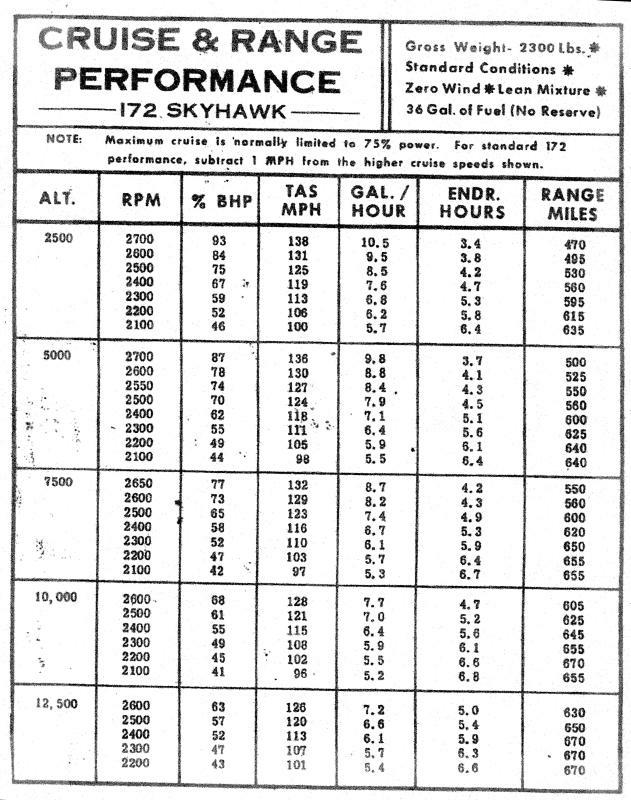Cessna 172 N2374U
Performance data
Take-off performance data
The following table gives take-off distances (in feet), with flaps up on a hard runway. The figures include an extra 10% allowance required by a FAA change sheet inserted into the POH.
| Density altitude | ||||||||||
|---|---|---|---|---|---|---|---|---|---|---|
| Sea level @ 59°F 15°C | 2500ft @ 50°F 10°C | 5000ft @ 41°F 5°C | 7500ft @ 32°F 0°C | |||||||
| Gross weight (lb) |
IAS at 50ft |
Head wind (mph) |
Ground run |
To clear 50ft obstacle |
Ground run |
To clear 50ft obstacle |
Ground run |
To clear 50ft obstacle |
Ground run |
To clear 50ft obstacle |
| 1700 | 60 | 0 | 435 | 780 | 520 | 920 | 625 | 1095 | 765 | 1370 |
| 10 | 290 | 570 | 355 | 680 | 430 | 820 | 535 | 1040 | ||
| 20 | 175 | 385 | 215 | 470 | 270 | 575 | 345 | 745 | ||
| 2000 | 65 | 0 | 630 | 1095 | 755 | 1325 | 905 | 1625 | 1120 | 2155 |
| 10 | 435 | 820 | 530 | 1005 | 645 | 1250 | 810 | 1685 | ||
| 20 | 275 | 580 | 340 | 720 | 425 | 910 | 595 | 1255 | ||
| 2300 | 70 | 0 | 865 | 1525 | 1040 | 1910 | 1255 | 2480 | 1565 | 3855 |
| 10 | 615 | 1170 | 750 | 1485 | 920 | 1955 | 1160 | 3110 | ||
| 20 | 405 | 850 | 505 | 1100 | 630 | 1480 | 810 | 2425 | ||
Return to top of page
Take-off distance calculator
The calculator below performs take-off distance calculations using the data from the table above. It works by calculating the density altitude (using the pressure, temperature, dew-point and airfield elevation), then interpolating between the data points in the table. The answer it gives is the Take-off Distance Required (TODR) - i.e. the distance needed to reach a height of 50 feet.
Important safety note: I use this calculator for doing take-off performance calculations before flying N2374U, but you should be aware that this calculator is specific to that particular aircraft. The answers it gives are not applicable to any other aircraft (not even other C172's). You must use the data taken from the POH of your particular aircraft.
Return to top of page
Cruise performance
The table below gives performance figures for various cruise power settings at a range of different altitudes. The numbers in grey represent power settings that the POH does not recommend for that altitude - power settings above about 70% power are not recommend for continuous cruising. Perhaps the most striking thing about these figures is the importance of correct mixture leaning technique - something which I feel is poorly taught in most PPL courses.
